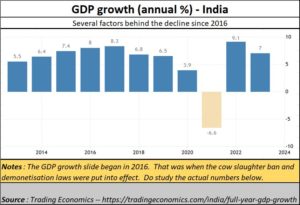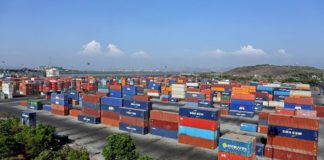India’s problems make it stumble
RN Bhaskar
Last fortnight has not been good for India. True, the prime minister exulted over the role India could play in the G-20, but there are smoke signals all around warning of dangerous times ahead. Problems abound.
 Inflation continues to be high. Unemployment has risen. This is even as India has the highest unemployment rates among its neighbours. That is indeed worrying. And GDP growth has stalled (https://www.livemint.com/news/india/india-q3-gdp-live-news-updates-india-q3-gdp-11677513172185.html). India’s trade balance is worsened, and exports appear to be under immense pressure.
Inflation continues to be high. Unemployment has risen. This is even as India has the highest unemployment rates among its neighbours. That is indeed worrying. And GDP growth has stalled (https://www.livemint.com/news/india/india-q3-gdp-live-news-updates-india-q3-gdp-11677513172185.html). India’s trade balance is worsened, and exports appear to be under immense pressure.
Call for a public enquiry
In fact, one of the things India ought to do is to get the G20 to ask for an open investigation into the blowing up of the Nordstream pipelines. The first 15 minutes of the videotaped submissions to the United Nations explain quite clearly why this should have been done. Prof. Jeffrey Sachs and Ray McGovern address the UN Security Council on the urgent need for Nordstream investigations (https://www.youtube.com/watch?v=R_EX-VwKjng).
Some of these facts were later reiterated by Russia’s foreign minister Sergey Lavrov at the Raisina dialogues in Delhi on 2 March 2023 (https://youtu.be/HfArU0yCO5M).
After all, unless such acts of international terrorism are brought under check, unilateral moves could soon spill over into a rogue nation ripping apart undersea telecommunication cables, blowing up tankers, or exploding satellites in space. Unilateralism in financial flows (the seizure of funds in respect of Afghanistan, Russia and Iran) has only made financial discussions and contracts to move to Dubai, rather to New York or London. Nobody trusts these financial centres anymore. Increasingly, more countries are now willing to enter transactions in non-dollar currencies.
Eventually, any kind of unilateralism which affects free flow of trade is bad for the entire world. It pushes up the cost of goods and services. It affects weaker countries more savagely than wealthier and more powerful nations. And it makes the world a more dangerous place to live and move around in. The cost of the Ukraine war has adversely affected the entire world, but more specifically India’s economy too (https://www.business-standard.com/article/economy-policy/how-russia-ukraine-conflict-has-impacted-global-and-indian-economy-123022301349_1.html).
 India and China mean a lot to each other
India and China mean a lot to each other
On another front, it is good that India and China are finally trying to work out ways to interact with each other more amicably. Both are the largest players in Asia. Ananth Krishnan has  brought out the issues that worry both nations quite eloquently in his latest article (https://indiachina.substack.com/p/qin-gang-comes-to-india-jaishankars?utm_source=post-email-title&publication_id=243879&post_id=105735531&isFreemail=true&utm_medium=email).
brought out the issues that worry both nations quite eloquently in his latest article (https://indiachina.substack.com/p/qin-gang-comes-to-india-jaishankars?utm_source=post-email-title&publication_id=243879&post_id=105735531&isFreemail=true&utm_medium=email).
India needs to do all it can to ensure that at least its eastern front is insulated against reckless warmongering. Such irresponsible churlishness has been promoted by both the US and the UK. Both have allocated the largest amounts to shore up Ukraine’s war machinery. Not surprisingly, other European countries are discomfited. Hungary has decided to break ranks with the rest of EU and join China for peace talks (https://www.scmp.com/news/china/diplomacy/article/3211885/breaking-eu-hungarys-leader-backs-chinas-peace-proposal-ukraine-war). Expect more EU members to do likewise, because they will be hurting, even while the US will be making money (https://asiaconverge.com/2022/02/ukraine-the-war-that-usa-wants/).
Unwise moves
But India’s moves are not always wise. Consider just two such moves. Its New Education Policy actually forbids educational institutions from studying Chinese. How short-sighted! If China is to be regarded as an enemy, you need to study the language of the enemy to understand it better. If it is a friend, you need to encourage cultural exchanges. Banning language-learning is a myopic move which should never have been taken. Today, the army runs its own schools to facilitate its soldiers along the border to study this language (https://www.internationalnewsandviews.com/know-why-indian-army-is-teaching-chinese-language/). Businessmen too do this, though discreetly.
Ditto with the banning of WeChat (https://www.livemint.com/news/india/govt-to-ban-54-chinese-apps-that-pose-threat-to-india-s-security-report-11644813401023.html) — a communication platform like WhatsApp — that many businessmen, tourists and students use both in India and China to exchange notes and keep in touch. Banning communication links only hurts business on both sides. And do bear in mind that India’s largest overseas population of students (around 25,000) studying medicine is in China. Currently they cannot be in touch as easily as before with their families in India because of this platform being banned.
India needs to avoid such rash moves.
Economic bumbling
India has not been very careful about its domestic economic policies as well.
Just look at the slowing down of GDP growth since 2016. It does not take a genius to understand that two factors have caused India to slow down. The first was a rash move to demonetise the Indian currency. That hurt small entrepreneurs immensely. These businesses account for over 90% of employment in this country (https://asiaconverge.com/2023/01/2023-has-begun-badly-for-india/).
The second, which continues to plague India, is the cow slaughter laws which, thanks to uncontrolled and frenzied gau rakshaks (cow protectors), have ended up as cattle slaughter bans. That in turn has affected small farmers the most (https://asiaconverge.com/2023/01/sodhis-resignation-has-dire-warnings-for-agriculture-and-milk/). It has slowed down the purchasing power of rural communities, and has in turn shrunk the purchasing power of rural India which accounts for 50% of population and jobs. Not a wise move at all.
This could have been remedied if the government had pumped in enough money to promote farmer run cooperatives. Yet, the largest milk producing state – Uttar Pradesh – is the most notorious for exploiting farmers (https://asiaconverge.com/2023/01/2023-has-begun-badly-for-india/).
Similarly, the PLI or the Production Linked Incentive scheme (https://asiaconverge.com/2022/10/pli-and-the-indian-economy/) is also worrying. On paper it looks visionary and good. Big industry welcomes it. But study the list of sectors that are targeted. Missing are leather and gems & jewellery. Both are labour intensive. Both are export earners. Like garments, leather and gems & jewellery have been the largest export-oriented businesses from India, primarily because they are labour intensive, and also because of Indian ingenuity.
Not surprisingly, India’s exports are not taking off as well as expected. And unemployment continues to blight the Indian landscape.
Tinkering with skillsets
Worse, the government has sought to tinker with skillsets peculiar to one region and has sought to transport them to other regions, with subsidies, incentives and even policy initiatives. Just look at the incentives Vedanta has been given for locating the semiconductor plant in Dholera (https://www.livemint.com/companies/news/vedanta-foxconn-selects-dholera-sir-for-first-semiconductor-facility-in-india-11676937485881.html). If only such incentives could have been extended to leather, cattle, and gems & jewellery in Maharashtra!
Consider how Mumbai, hitherto the financial capital of India, suddenly saw the International Finance Centre (IFC) being shifted to Gujarat. Read the Percy Mistry reports and other recommendations over the past two decades. They all talk of Mumbai being the hub for the IFC.
Then look at the gold markets that have traditionally being headquartered in Mumbai, though gold craftsmen dot the landscape across the country. Suddenly, the gold bourse is also shifted to Gujarat. Ditto with the diamond bourse (https://asiaconverge.com/2022/07/mahesh-gadhavi-on-the-surat-diamond-bourse/). When you try relocating traditional centres, you actually slow down the growth of these sectors. Competition may be healthy, but not when it is aimed at shifting entire industries out of traditional bases.
Undoubtedly, India can grow faster than China. But that means not hobbling its entrepreneurs and industry with wobbly pitches.
And do remember that a negative trade balance with China is not as bad as economists sometimes try to portray it. Much of what is imported are basic raw materials. They are used mostly by pharmaceutical companies. Much of the pharma output is then exported. Hence the imports from China do contribute immensely to India’s exports. That is a story that needs to be told, because both countries with their large populations can become mutually beneficial for joint prosperity.
Poverty reduction also depends on two other factors –
- a good focus on education (https://asiaconverge.com/2022/05/india-wont-prosper-till-education-and-employability-improve/) and
- excellent health care (https://asiaconverge.com/2020/05/atma-nirbhar-bharat-and-healthcare-headed-for-the-icu/). Those are the areas the government needs to focus on.
But if politics and ideology are allowed to interfere with the natural growth of enterprise and business, or even learning, then India’s growth path will be extremely rocky.
India needs to regain its balance. At present it is wobbling.






































COMMENTS